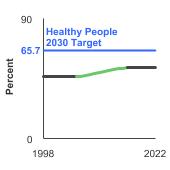On This Page:
Background
Quitting smoking has major and immediate health benefits for people of all ages. Quitting smoking dramatically reduces the risk of lung and other cancers caused by smoking, coronary heart disease, stroke, and chronic obstructive pulmonary disease (COPD). For example, 10-15 years after quitting, the risk of lung cancer decreases to about one-half that of a person who continues to smoke; with continued abstinence from smoking, the risk of lung cancer decreases even further.
Although quitting smoking is beneficial at any age, the earlier in life a person quits, the more likely it is that they will avoid the devastating health effects of continued tobacco use. Few people who smoke quit successfully on their first attempt; most will require many attempts before they are able to permanently quit. This emphasizes the need for those who smoke to begin trying to quit as early in life as possible.
A number of strategies can increase the likelihood of successful smoking cessation. For example, comprehensive, barrier-free, and widely promoted access to insurance coverage for smoking cessation treatment increases treatment use and successful cessation. Treatments that support successful cessation include FDA approved smoking cessation medications and behavioral counseling; the combination of medication and counseling is especially effective. Behavioral counseling and support can be delivered using individual or group counseling, or by quitlines, web and internet, or text-messaging platforms. Cessation rates can also be improved by adopting population-level policies, such as tobacco product price increases, comprehensive smokefree policies, implementing anti-tobacco mass media campaigns, requiring pictorial health warnings on tobacco products, and maintaining comprehensive statewide tobacco control programs.
Recently, the FDA announced a proposal to prohibit menthol as a characterizing flavor in cigarettes and all characterizing flavors (other than tobacco) in cigars. These proposed rules have the potential to significantly reduce the death and disease caused by smoking by reducing youth use and experimentation, and by increasing the number of people that quit. In addition, the FDA also announced plans to develop a proposed product standard that would establish a maximum nicotine level to reduce the addictiveness of cigarettes and some other combustible tobacco products. The goal of this proposed product standard would be to reduce youth use, addiction, and death.
Measure
Attempt to quit: The percentage of adults (aged 18 years and older) who attempted to quit smoking within the past 12 months. The numerator of this measure includes both people who currently smoke every day or some days and who, at the time of the survey, had quit smoking for at least 1 day during the past 12 months, as well as people who quit smoking less than or equal to 1 year ago. The denominator of this measure includes all adults who smoked 12 months prior to the survey.
Successful quitting: The percentage of adults (aged 18 years and older) who smoke and successfully quit smoking in the past 12 months. The numerator of this measure includes adults who quit smoking 6-12 months prior to the survey. The denominator of this measure includes adults who:
- Formerly smoked and had quit smoking 6-12 months prior to the survey.
- Formerly smoked and had quit smoking less than 6 months prior to the survey.
- Currently smoked at the time of the survey and who initiated smoking at least 2 years prior to the survey.
Data Source
Centers for Disease Control and Prevention, National Center for Health Statistics, National Health Interview Survey 1998-2022.
Refer to the Data Sources page for more information about data collection years 2019+.
Healthy People 2030 Target
- Increase to 65.7 percent the proportion of adults who currently smoked (aged 18 years and older) who stopped smoking for a day or longer because they were trying to quit.
- Increase to 10.6 percent the proportion of adults who smoked (aged 18 years and older) who successfully quit smoking.
Healthy People 2030 is a set of goals set forth by the Department of Health and Human Services.
Note: Goals are indicated as blue line on Detailed Trend Graphs.
Trends and Most Recent Estimates
Attempted to Quit Smoking
By Sex
| Overview Graph | Detailed Trend Graphs | Most Recent Estimates (2022) | |
|---|---|---|---|
| Percent | 95% Confidence Interval | ||
  |
Both Sexes |
53.0 | 50.9 - 55.2 |
Male |
52.9 | 50.1 - 55.6 | |
Female |
53.1 | 49.4 - 56.8 | |
By Race/Ethnicity
| Overview Graph | Detailed Trend Graphs | Most Recent Estimates (2022) | |
|---|---|---|---|
| Percent | 95% Confidence Interval | ||
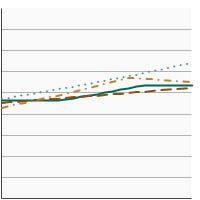  |
All Races/Ethnicities |
53.0 | 50.9 - 55.2 |
Non-Hispanic White |
50.2 | 47.6 - 52.8 | |
Non-Hispanic Black |
60.3 | 55.0 - 65.3 | |
Hispanic |
55.2 | 49.4 - 60.8 | |
By Age
| Overview Graph | Detailed Trend Graphs | Most Recent Estimates (2022) | |
|---|---|---|---|
| Percent | 95% Confidence Interval | ||
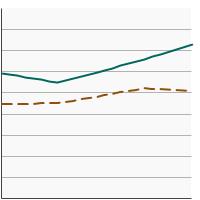  |
Ages 18-24 |
78.3 | 69.8 - 84.9 |
Ages 25 and older |
50.2 | 48.3 - 52.2 | |
By Poverty Income Level
| Overview Graph | Detailed Trend Graphs | Most Recent Estimates (2022) | |
|---|---|---|---|
| Percent | 95% Confidence Interval | ||
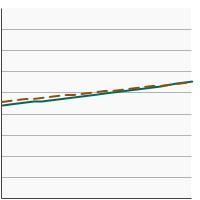  |
<200% of federal poverty level |
52.7 | 49.3 - 56.0 |
>=200% of federal poverty level |
53.4 | 50.4 - 56.3 | |
By Education Level
| Overview Graph | Detailed Trend Graphs | Most Recent Estimates (2022) | |
|---|---|---|---|
| Percent | 95% Confidence Interval | ||
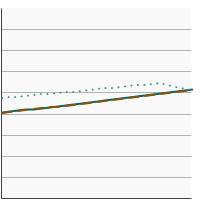  |
Less than High School |
46.8 | 41.5 - 52.3 |
High School |
49.8 | 46.6 - 53.0 | |
Greater than High School |
51.3 | 48.4 - 54.2 | |
Successfully Quit Smoking
By Sex
| Overview Graph | Detailed Trend Graphs | Most Recent Estimates (2022) | |
|---|---|---|---|
| Percent | 95% Confidence Interval | ||
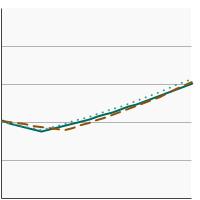  |
Both Sexes |
9.6 | 8.4 - 10.9 |
Male |
8.9 | 7.4 - 10.7 | |
Female |
10.8 | 8.9 - 13.1 | |
By Race/Ethnicity
| Overview Graph | Detailed Trend Graphs | Most Recent Estimates (2022) | |
|---|---|---|---|
| Percent | 95% Confidence Interval | ||
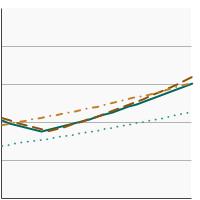  |
All Races/Ethnicities |
9.6 | 8.4 - 10.9 |
Non-Hispanic White |
9.8 | 8.3 - 11.4 | |
Non-Hispanic Black |
9.0 | 5.0 - 15.8 | |
Hispanic |
11.0 | 7.9 - 15.2 | |
By Age
| Overview Graph | Detailed Trend Graphs | Most Recent Estimates (2022) | |
|---|---|---|---|
| Percent | 95% Confidence Interval | ||
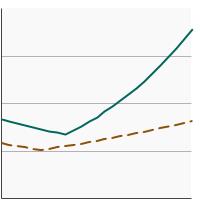  |
Ages 18-24 |
17.0 | 9.6 - 28.5 |
Ages 25 and older |
8.7 | 7.6 - 10.0 | |
By Poverty Income Level
| Overview Graph | Detailed Trend Graphs | Most Recent Estimates (2022) | |
|---|---|---|---|
| Percent | 95% Confidence Interval | ||
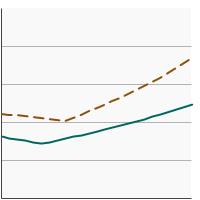  |
<200% of federal poverty level |
8.3 | 6.7 - 10.3 |
>=200% of federal poverty level |
10.6 | 8.9 - 12.5 | |
By Education Level
| Overview Graph | Detailed Trend Graphs | Most Recent Estimates (2022) | |
|---|---|---|---|
| Percent | 95% Confidence Interval | ||
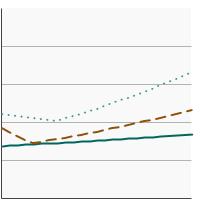  |
Less than High School |
4.0 | 2.5 - 6.4 |
High School |
7.5 | 6.0 - 9.4 | |
Greater than High School |
11.0 | 9.3 - 13.0 | |
Additional Information
- Tobacco. National Cancer Institute.
- Smoking & Tobacco Use – Quit Smoking. Centers for Disease Control and Prevention.
- Public Health Education. U.S. Food and Drug Administration.
Quitting Smoking Resources
- Smokefree.gov. National Cancer Institute.
- Cigarette Smoking: Health Risks and How to Quit (PDQ®)–Patient Version. National Cancer Institute.
- How to Quit Using Tobacco. American Cancer Society.
- How to Quit Smoking. Centers for Disease Control and Prevention.
- A Socioecological Approach to Addressing Tobacco-Related Health Disparities. U.S. National Cancer Institute. National Cancer Institute Tobacco Control Monograph 22. NIH Publication No. 17-CA-8035A. Bethesda, MD: U.S. Department of Health and Human Services, National Institutes of Health, National Cancer Institute; 2017.
- The Economics of Tobacco and Tobacco Control. U.S. National Cancer Institute and World Health Organization. National Cancer Institute Tobacco Control Monograph 21. NIH Publication No. 16-CA-8029A. Bethesda, MD: U.S. Department of Health and Human Services, National Institutes of Health, National Cancer Institute; and Geneva, CH: World Health Organization; 2016.
- Tobacco Control Evidence-Based Programs Listing. National Cancer Institute.
- Smoking Cessation: A Report of the Surgeon General. Centers for Disease Control and Prevention.
- Healthcare Provider Resources: Smoking and Tobacco Use. Centers for Disease Control and Prevention.
- North American Quitline Consortium. North American Quitline Consortium.
- Interventions for Tobacco Smoking Cessation in Adults, Including Pregnant Persons. U.S. Preventive Services Task Force.
- Prevalence and determinants of cigarette smoking relapse among US adult smokers: a longitudinal study. Alboksmaty A, Agaku IT, Odani S, Filippidis FT. BMJ Open. 2019;9(11):e031676.
- Anti-Smoking Media Campaigns and Disparities in Smoking Cessation in the United States, 2001-2015. Colston DC, Cho B, Thrasher JF, et al. Am J Health Promot. 2021 Jan 8:890117120985818.
- Tobacco Product Use and Cessation Indicators Among Adults - United States, 2018. Creamer MR, Wang TW, Babb S, et al. MMWR Morb Mortal Wkly Rep. 2019;68(45):1013-1019.
- State Tobacco Excise Taxation, Comprehensive Smoke-free Air Laws, and Tobacco Control Appropriations as Predictors of Smoking Cessation Success in the United States. Dahne J, Nahhas GJ, Wahlquist AE, Cummings KM, Carpenter MJ. J Public Health Manag Pract. 2020;26(5):E1-E4.
- Relapse Prevention Interventions for Smoking Cessation. Livingstone-Banks J, Norris E, Hartmann-Boyce J, et al. Cochrane Database Syst Rev. 2019;2019(10).
- Targeted smoking cessation for dual users of combustible and electronic cigarettes: a randomised controlled trial. Martinez U, Simmons VN, Sutton SK, et al. Lancet Public Health. 2021;6(7):e500-e509.
- Longitudinal Associations Between Use of Tobacco and Cannabis Among People Who Smoke Cigarettes in Real-world Smoking Cessation Treatment. Nguyen N, Neilands TB, Lisha NE, Lyu JC, Olson SS, Ling PM.J Addict Med. 2022 Jul-Aug 01;16(4):413-419.
- Heterogeneity in Past-Year Smoking, Current Tobacco Use, and Smoking Cessation Behaviors Among Light and/or Non-Daily Smokers. Omole T, McNeel T, Choi K. Tob Induc Dis. 2020;18:74.
- Intersectionality and Smoking Cessation: Exploring Various Approaches for Understanding Health Inequities. Potter LN, Lam CY, Cinciripini PM, Wetter DW. Nicotine Tob Res. 2021 Jan 7;23(1):115-123. doi: 10.1093/ntr/ntaa052. PMID: 32208484; PMCID: PMC7789945.
- Enhancing employer coverage of smoking cessation treatment: A randomized trial of the Partners in Helping You Quit (PiHQ) program. Rigotti NA, Kelley JHK, Regan S, et al. Prev Med. 2020;140:106216.
- Smoking-Cessation Interventions for U.S. Young Adults: Updated Systematic Review. Villanti AC, West JC, Klemperer EM, et al. Am J Prev Med. 2020;59(1):123-136.
- Characteristics and Correlates of Recent Successful Cessation Among Adult Cigarette Smokers, United States, 2018. Walton K, Wang TW, Prutzman Y, Jamal A, Babb SD. Prev Chronic Dis. 2020;17:E154.
- The Tobacco Use Supplement to the Current Population Survey. National Cancer Institute.
- The National Health Interview Survey Cancer Control Supplements. National Center for Health Statistics, co-sponsored by the National Cancer institute/DCCPS and the Centers for Disease Control and Prevention/OSH and DCPC.
- Population Assessment of Tobacco and Health (PATH) Study Series. National Institute on Drug Abuse, National Institutes of Health, and the Center for Tobacco Products, Food and Drug Administration.
